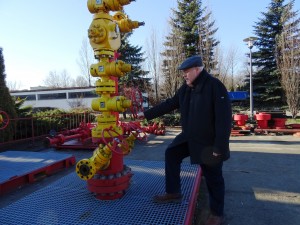“A concern for gas security “
By: Nicholas Newman
Forecasting the future is always subject to many intervening unknowns including “Black Swan’s”, the proverbial banana skins and Acts of God that makes it safer to predict things after they have happened. Despite these well-known and accepted reservations a group of Britain’s leading industry gas experts contributed to a OFGEM seminar entitled GB Gas Security of Supply Seminar on 2 February 2012 held at London’s Institute of Mechanical Engineering. Foremost among the questions addressed were the following:
• Where in future will gas supplies come from?
• Will there be sufficient gas and how much will it cost?
• Does Britain need more gas storage capacity?
• How stable will gas prices be?
• Is the UK becoming dangerously vulnerable to its dependence upon imports of gas, especially from Qatar?
• Will America start exporting gas from 2014 onwards?
Where in future will gas supplies come from?
In the recent past Western Europe’s governments and consumers focused upon the availability and security of supplies of Russian gas. In the near future, Howard Rogers at the Oxford Institute of Energy Studies suggested that other factors, especially the spectacular growth in shale gas production in the United States, as well as growing Asian demand will be equally as important to European markets and the UK, which is increasingly becoming reliant on the world’s current leading LNG exporter Qatar. In fact, Alistair Buchanan Chief Executive of OFGEM observed that as early as 2014 the United States will have a surplus of exportable shale gas which awaits the conversion of LNG import terminals in export facilities at ports along its eastern and southern coastlines.
While Anne-Sophie Corbeau, at the International Energy Agency proposed additional factors to be added into Britain’s gas supply equation. These include consideration of the security of gas supplies from the world’s leading LNG gas exporter Qatar, the growth of Asian demand for gas, as well as the size and speed of nuclear power station building programmes in such countries as China on the future growth in the demand for gas.
The latest UK government figures show that imports of Qatari LNG amounted to 52% of total gas consumed in the first nine months of 2011: this is up from just 11% in 2009! The trouble for the UK and Europe is that Qatar’s exports are destined not only for Britain and Europe, but also for Asian States such as China, South Korea and Japan.
Will there be sufficient gas and how much will it cost?
We have already seen the “Black Swan” effect of the Fukishima disaster – the closure of several Japanese nuclear power plants leading to a spike in the price of gas as Japanese power producers switched to imported gas. In future years it is safe to predict a growth in gas prices due to rising Asian demand. In future growing Asian demand for global supplies of gas are likely to push global prices up further. This will inevitably mean a significant rise in Qatari gas for European gas consumers.
It is therefore not surprising, that Britain and Europe is actively searching for potential alternative secure gas supplies, most notably by importing American shale gas, developing domestic sources of shale gas as in Lancashire and most notably in Poland. However, Poyry Energy Consultant and expert on shale gas Lucy Fields, has pointed out that due to various environmental, legal and geological factors, Europe is unlikely to replicate an “American” style shale gas revolution.
Nevertheless, by the end of the decade, Europe is likely to see its first imports of gas from Australia’s supergiant offshore gas fields Wheatstone and Gorgon. Overall the world has plenty of gas available, the question is will Britain and its fellow European partners be prepared to pay the high prices that the market might demand.
Will America start exporting gas from 2014 onwards?
Although, several projects to convert existing LNG import terminals along the US east and Gulf of Mexico coasts are being planned, with the first ones due to start operating in 2014. The prospect of American gas supplies being available to be exported to Europe depends on the following factors suggests Alistair Buchanan:
- The timing of U.S. regulators policy decisions to push for a switch from coal to gas power for domestic consumption,
- How quickly its economy grows in the coming years,
Already, energy traders have taken into account the prospective arrival of cheap US shale gas into lowering wholesale gas prices, at least in the short run. However, the prospect of US gas exports to Europe is not yet a “done deal” with the current Obama administration, owing to the American Government’s own focus on long-term energy self-sufficiency.
What is energy security”?
Pierre Noël, from Cambridge University’s Electrical Policy Research Group, addressed the question “what is energy security”? He defines energy supply security as “the ability of the energy system to meet contracted final energy demand under a gas supply disruption, at peak time”. However, risk adverse politicians tend to distrust the ability of international markets to top up domestic supplies as, and when, required. Moreover, for political as well as economic reasons, politicians are against sudden price spikes caused by any disruption to supplies. Economists however, regard such market developments as an efficient method of rationing gas supplies.
Therefore, Europe’s political energy leaderships will seek to minimise potential disruptions on UK and European gas supply availability. As a result of the disruptions caused by the regular Russian-Ukrainian gas supply disputes, European Union Member States have adjusted market conditions in Europe in order to encourage greater cooperation between operators as well as increased storage capacity. In Britain, political concern has focused upon the country’s insufficient gas storage capacity.
Does Britain need more gas storage capacity?
The UK’s current storage capacity amounts to only 14 days’ worth of gas supply, a dangerously low level compared with France’s 87 days, Germany’s 69 and Italy’s 59 days of gas supply, according to last December’s Report by MPs on the Energy and Climate Change Committee. However, this scenario is not as clear-cut as it initially appears. It has been argued by some energy analysts, that the reason gas storage capacity in the UK has not been significantly increased to match European levels owe much to the following factors:
• the UK’s massive gas import capacity
– via its interconnector’s with the Continent, especially to the Norwegian gas fields
-developments at Milford Haven in Wales
– UK LNG import capacity.
• The conviction that there is sufficient capacity to cope with most peak time disruption scenarios envisaged in the years ahead.
• UK domestic gas production
In order to improve the U.K.’s ability to withstand gas supply disruption the government has recently given the go-ahead for Gateway Storage Company to construct a new offshore gas storage facility, not far from Barrow in Furness in Lancashire. Once completed, the undersea caverns will have a working gas storage capacity of 1.52 billion standard cubic metres (~562 million therms), adding nearly 30% to current UK gas storage capacity. Once this facility is completed in 2014, the United Kingdom should have a similar storage capacity for gas equal to that of Holland and in the longer term investors have plans to double the U.K.’s current storage capacity to match that of either France or Germany.
How stable will gas prices be?
As for banana skins, the unintended consequences of the drive to uncouple the indexation of gas prices with oil prices is a good example. It was intended to increase competition and lower gas prices in Europe by ending the practice of long term gas supply contracts between gas consumers and producers. Unfortunately, the unintended consequences have been that gas prices are now more volatile and less predictable than before, making planning more difficult.
In the long term, it is predicted that European gas prices will continue to increase, due to the increased demand by European, Asian and American power generators. However, the real question is, where will Europe obtain its future gas supplies. I would not be surprised because of higher gas prices the European Union will be actively developing new gas fields in the Arctic regions.
This seminar was part of OFGEM’s first major effort to gather industry views on the UK’s gas supply prospects following the DECC request last year, an OFGEM spokesman said. However, what this seminar revealed was the major differences between gas producers, traders, consumers and regulators about the future course of UK gas supplies. It also revealed how such “Black Swans” developments, such as the arrival of the American shale gas revolution, was unforeseen by many experts just a couple of years ago. In addition, the debate in the question-and-answer sessions revealed how successful acts of leadership implemented via European energy policy has been on affecting the growth in demand for gas and how the market can be made to operate to meet the greater good of the economy.
See: Black Swans Bring New Challenges to Energy Leadership
For details of the slides used in seminar see: http://www.ofgem.gov.uk/About%20us/PwringEnergyDeb/Pages/PwringEnergyDeb.aspx
http://rcm-uk.amazon.co.uk/e/cm?t=oxfordproscou-21&o=2&p=8&l=as1&asins=B00684EBC0&ref=tf_til&fc1=000000&IS2=1<1=_blank&m=amazon&lc1=0000FF&bc1=000000&bg1=FFFFFF&f=ifr
 Oil Review Africa in London, United Kingdom
Oil Review Africa in London, United Kingdom Nicnewmanoxford.com reports and features were about:
Nicnewmanoxford.com reports and features were about:




![MP900437258[1]](https://energyjournalist.files.wordpress.com/2011/12/mp9004372581.jpg?w=300&h=189)

